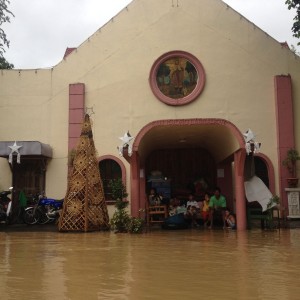It’s Christmas atop dikes in many towns
CITY OF SAN FERNANDO —Thousands of people in Pampanga and Bulacan’s coastal villages may be spending Christmas Day in evacuation centers or atop dikes, as the Pampanga River continues to drain water from Nueva Ecija, one of the provinces hardest hit by Typhoon “Nona.”
Heavy rain kept falling in Luzon as a result of a cold front that was dragged into the country by Nona (international name: Melor) and Tropical Depression “Onyok,” which hit the country in succession last week.
Flooding will “persist for a few days” in Arayat, San Luis and San Simon towns in Pampanga, the Pampanga River Flood Forecasting and Warning Center (PRFFWC) said on Sunday.
The center said the floods would linger for several days in Candaba town in Pampanga, as well as in San Miguel and San Ildefonso towns in Bulacan.
Floods are expected to stay for a few days in Apalit, Macabebe and Masantol towns in Pampanga and in Calumpit, Hagonoy and Paombong towns in Bulacan.
The PRFFWC also warned of flooding in the riverine towns of Angat, Norzagaray, Bustos, Baliwag, Pulilan and Plaridel, all in Bulacan.
Article continues after this advertisementCatch basins
Article continues after this advertisementHagonoy, which is a natural catch basin for water draining out of Pampanga before discharging into Manila Bay, has suffered from up to more than a meter of floodwater.
In villages in Calumpit, also a natural catch basin, floodwater rose to 3 meters in some neighborhoods.
“Our home has been flooded up to the waist. It has been flooded for more than two days,” Mary Jane Bautista, 35, said in Calumpit, Bulacan.
Her family and several others were forced to take refuge on nearby high ground—in front of a church where their only shelter was the awning over the entrance.

REFUGE FROM THE STORM The San Isidro Labrador Chapel took in two families from Barangay IbaO’Este in Calumpit town, Bulacan province, whose houses were flooded on Saturday due to the rains spawned by Typhoon “Nona.” The chapel had to suspend its 7 p.m.Mass to accommodate the evacuees. CARMELA REYES-ESTROPE
“My husband has to wade through the waters to go home to get supplies. If we need water, he has to go to the faucet in our kitchen,” she said, expressing fears the current could wash him away.
“We had some food but it just ran out,” she said, complaining that government relief items had not yet reached her.
Around her the streets had turned into fast-moving rivers, passable only to rowboats and people using inner tubes.
“It (the flood) really takes a long time to recede because this is the lowest area,” said Glenn Diwa, an officer with the regional disaster council.
Evacuation centers
Diwa said more than 54,000 people in Central Luzon were huddling in government evacuation centers.
Calumpit Mayor Jessie de Jesus said this was the second time in less than two months that his town was struck by floods. In October, floods rampaged through the town due to rains dumped by Typhoon “Lando.”
Calumpit and Hagonoy also experienced two floods in succession in 2004, De Jesus said. “This week’s flood, however, is far more widespread [compared to Calumpit’s 2004 experience],” he said.
He said residents were worried about the excess water released by the Angat, Ipo and Bustos dams in Bulacan.
Angat opened a floodgate on Saturday afternoon after runoff rainwater rose beyond the reservoir’s spilling point of 212 meters above sea level. On Sunday, its reservoir level was 215.92 masl.
In Pampanga, 62 villages in Arayat, Apalit, Candaba, Masantol, Macabebe, San Luis and San Simon remained flooded on Sunday, according to a report from the Provincial Disaster Risk Reduction and Management Council.
Generally good weather
Amid the flooding, the country can look forward to generally good weather this week.
In its forecast for the week up to Dec. 25, the weather bureau said the “whole country will generally have improved weather” with only isolated rains and thunderstorms.
The low-pressure area residue from the northeast monsoon was expected to weaken this week, said forecaster Aldczar Aurelio of the Philippine Atmospheric Geophysical and Astronomical Services Administration (Pagasa).
It combined with the tail end of a cold front in the wake of Nona to cause flash floods over most of Luzon, including Metro Manila.
Onyok dissipated early Sunday over Mindanao.
For Dec. 21, however, Pagasa warned that Aurora and Quezon provinces would continue to be threatened by flash floods and landslides due to moderate to heavy monsoon rains.
The Bicol region will continue to experience light to moderate rains due to the tail end of a cold front, the weather bureau said. The rest of Luzon will have light rains, while the Visayas and Mindanao will have isolated rain showers or thunderstorms.
“There is no weather disturbance within the next three days,” Aurelio said. With a report from AFP